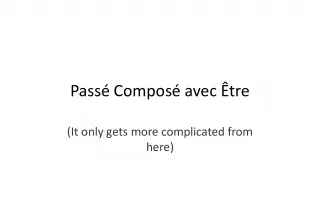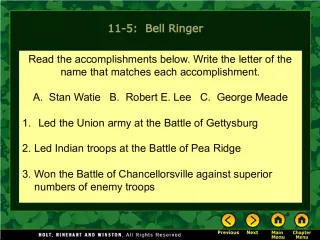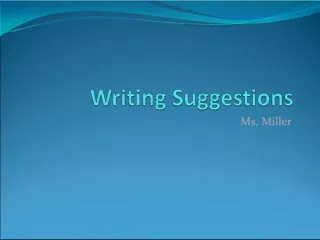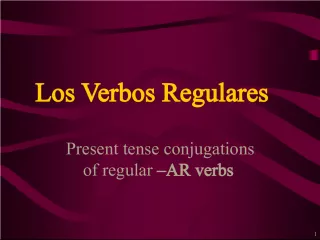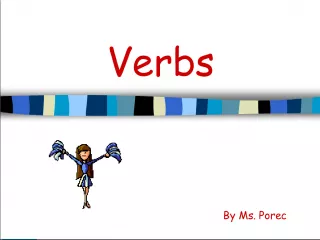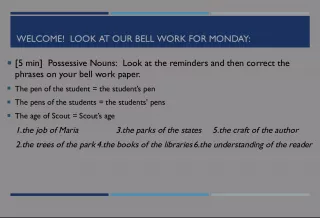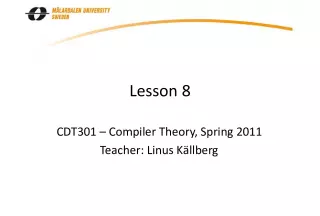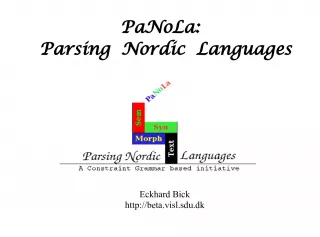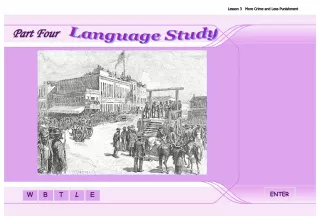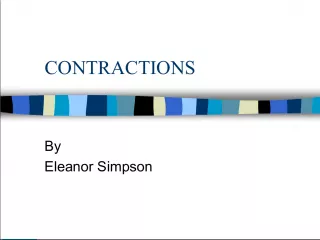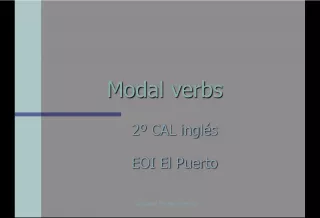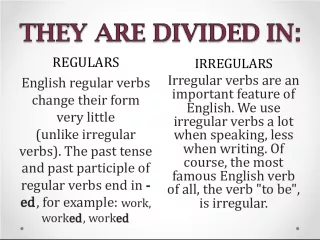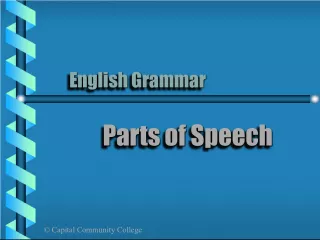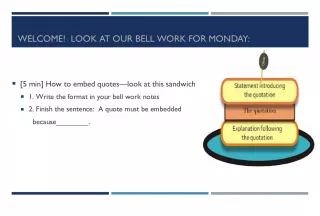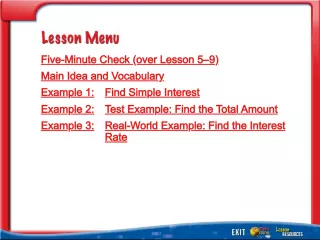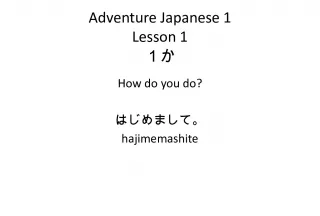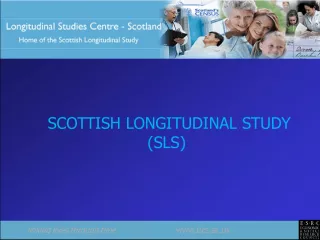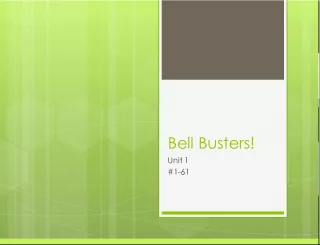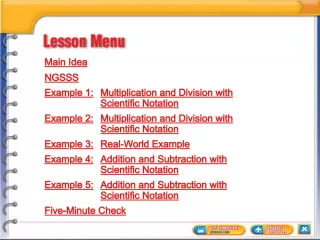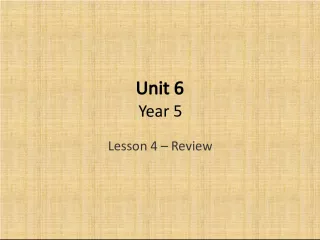Bell Ringer and Grammar Lesson on Linking Verbs


The article talks about a bell ringer prompt asking students to choose a place they would like to visit and a grammar lesson on linking verbs. It explains what linking verbs are and how they join the subject with the rest of the sentence. Examples are also given.
- Uploaded on | 1 Views
-
 charliewang
charliewang
About Bell Ringer and Grammar Lesson on Linking Verbs
PowerPoint presentation about 'Bell Ringer and Grammar Lesson on Linking Verbs'. This presentation describes the topic on The article talks about a bell ringer prompt asking students to choose a place they would like to visit and a grammar lesson on linking verbs. It explains what linking verbs are and how they join the subject with the rest of the sentence. Examples are also given.. The key topics included in this slideshow are bell ringer, grammar lesson, linking verbs, subject, sentence,. Download this presentation absolutely free.
Presentation Transcript
1. Bell Ringer #2: 9/3 (A) & 9/7 (B) As you enter class, please respond to the following prompt: If you could take a trip and visit any place in the world, where would you go and why? Explain.
2. Grammar Lesson: Linking Verbs
3. What is a LINKING VERB?? A linking verb joins the subject with the rest of the sentence. They are often forms of the verb to be
4. Linking Verbs They do not express ACTION . For example: Kyra is a shopaholic. IS-ing is not something that Kyra can do . IS connects Kyra, the subject , with shopping, the verb .
5. Linking Verbs During the afternoon, my cats are content to nap on the couch. ARE-ing isnt something that cats can do. Are connects the subject, cats , with something we say about themthey like to sleep on the furniture.
6. Lets sing a song To the tune of London Bridge Be am is are was were been Has have had Do does did Can could shall should will would may Might must being
7. Or this song if you prefer. . . To the tune of Camptown Ladies Am, is, are, was, were, be, been, being, being Am, is, are, was, were, be, been, Oh! Being verbs.
8. Verbs with multiple personalities Appear, feel, grow, look, prove, remain, smell, sound, taste, and turn Sometimes these verbs are ACTION verbs and sometimes they are LINKING verbs.
9. Okay, Lets practice Hold up your hand if you know what the linking verb in each sentence is. Be ready to share with the class. 1. The old house is haunted. 2. That was a delicious pie. 3. Antonio is the fastest runner on the team. 4. Your clothes are filthy. 5. Irene always feels sleepy after wolfing down pizza from Donatos.
10. Now, lets do this as partners. After each sentence, share what you think the linking verb in the sentence is with the person sitting next to you. 6. The large, barking dogs were scary. 7. A ten-item quiz seems impossibly long after a night of no studying. 8. There were five fish in the aquarium. 9. After drinking the old, curdled milk, Barney Fife turned green. 10. Allen and Francisco have been quiet all afternoon.
11. Now, on your grammar worksheet number your paper 1-7 and write down the linking verb in each of these sentences. 1. The mushroom and papaya pizza smells heavenly. 2. The spicy squid eyeball stew tasted good to Roderick. 3. Those jackets are too small, Billy. 4. My socks are in the top dresser drawer. 5. The printer has been out of ink all week. 6. My dog Oreo feels depressed after seven straight days of rain. 7. Will you be on time for our date tomorrow?
12. Notes: S.O.A.P.S.
13. S.O.A.P.S. Review 1. Which of the following is the main idea of the passage, Count Dracula: Fact or Fiction? a. The real and the fictional Draculas had some common traits. b. The story of Dracula is based on fact. c. The real Dracula drove stakes into the victims bodies. 2. This passage is about a. Vampire bats b. the Dracula legend. c. Count Dracula as a cruel man. d. Transmitters of disease. 3. Which of the following does the S in S.O.A.P.S. stand for? a. Situation b. Subject c. Start d. Symbolism 4. When referring to the O in S.O.A.P.S., which of the following refers to the situation surrounding the piece of writing that helps us better understand the intended message? a. Content c. Context b. Current Events d. Character
14. S.O.A.P.S. A- Audience To whom is the author writing? Who would care about this subject? P- Purpose Why is the author writing this? What does the author hope to accomplish with it? Inform, entertain, persuade (there is always ONE main purpose) Remember PIE (persuade, inform, entertain) Ex: Can you think of examples of TV shows/content that have these purposes?
15. Reading: Corpse Exhibit
16. REVIEW: S, O SKILL FOCUS: A, P Stations: High-Interest Articles
17. Practice: Station Activity Read the article with your team and use the poster paper provided to identify the S, O, A, and P of your given article as well as give a quick summary about what you read. Posters will be displayed in the classroom and each group with present their analysis to the rest of the class. Thank you in advance for your hard work. Keep in mind what concepts were difficult for you to comprehend, and find a way to present them in such a way that your classmates get it. Expectations : Stay with your group. Participate. Talk just loud enough for your group members to hear (not everyone in the room). Raise your hand if you need help or attention. Work for the entire amount of time. BE CREATIVE!!!
18. Homework: (write in planner) Find an article from a newspaper or magazine that you have at home or get online and find a digital copy. 1. Complete the Subject , Occasion , Audience, and Purpose for the text. 2. Be sure to bring the article (hard copy or printed copy) to class with your homework.
